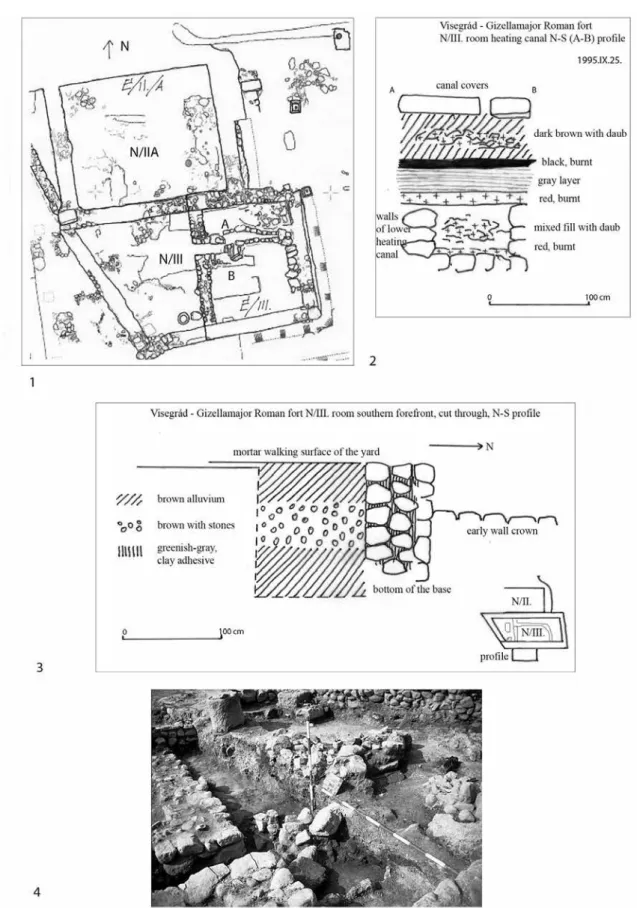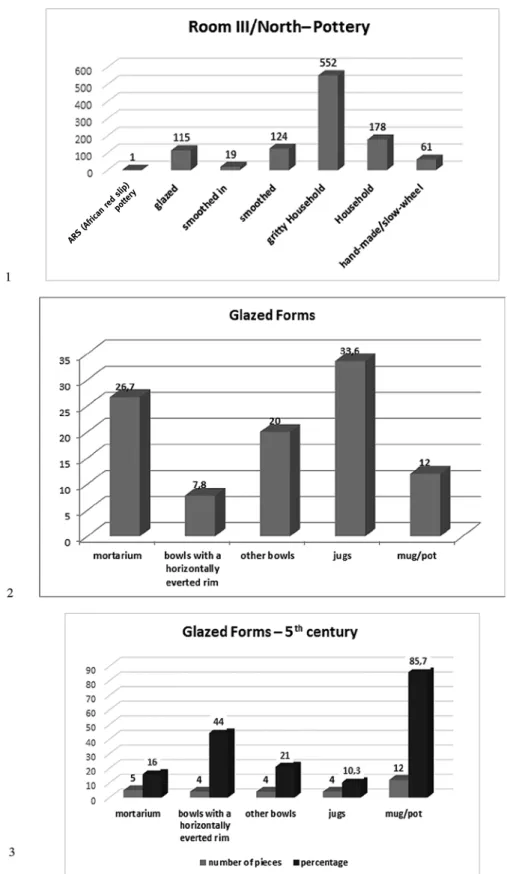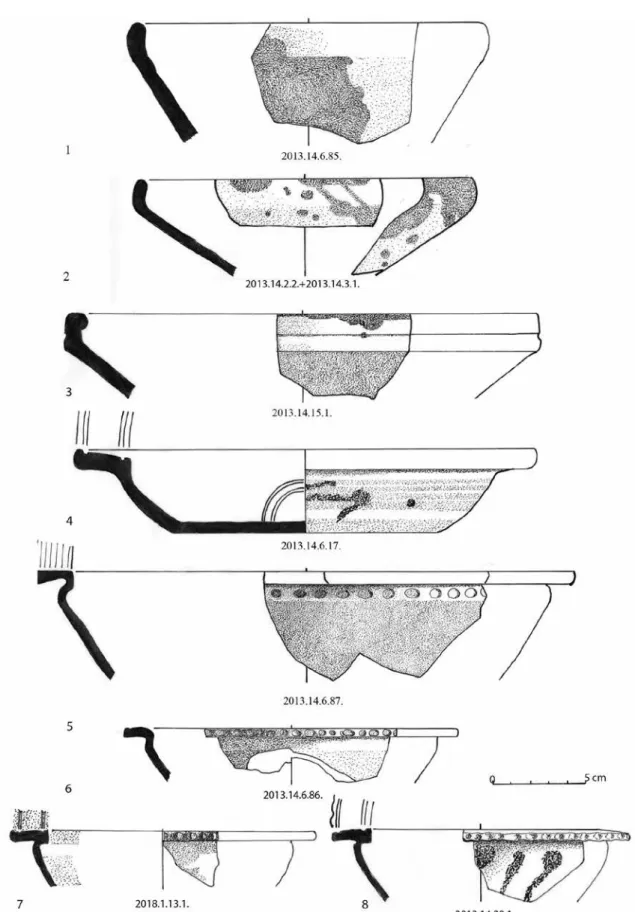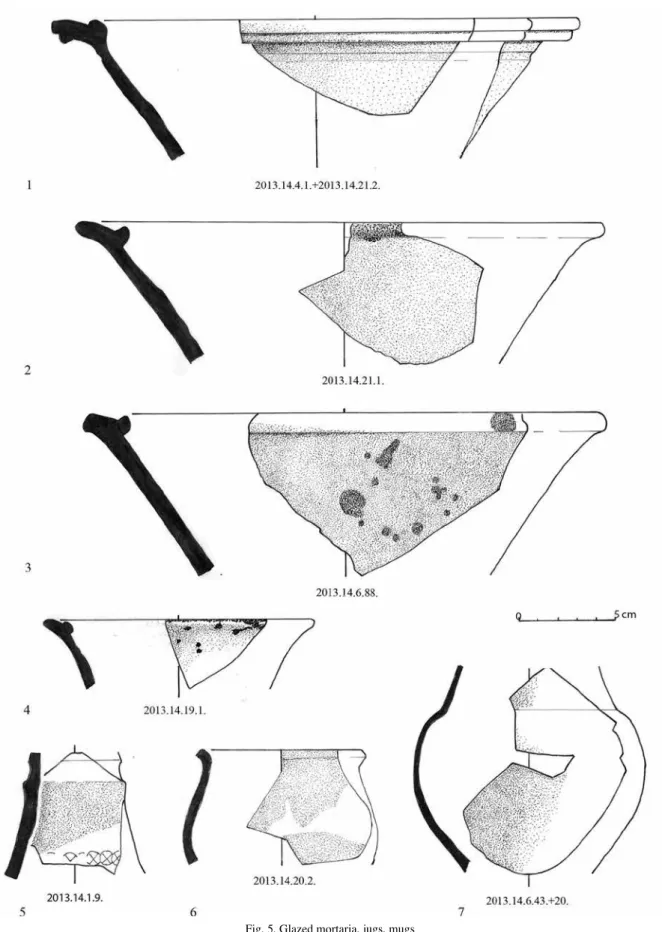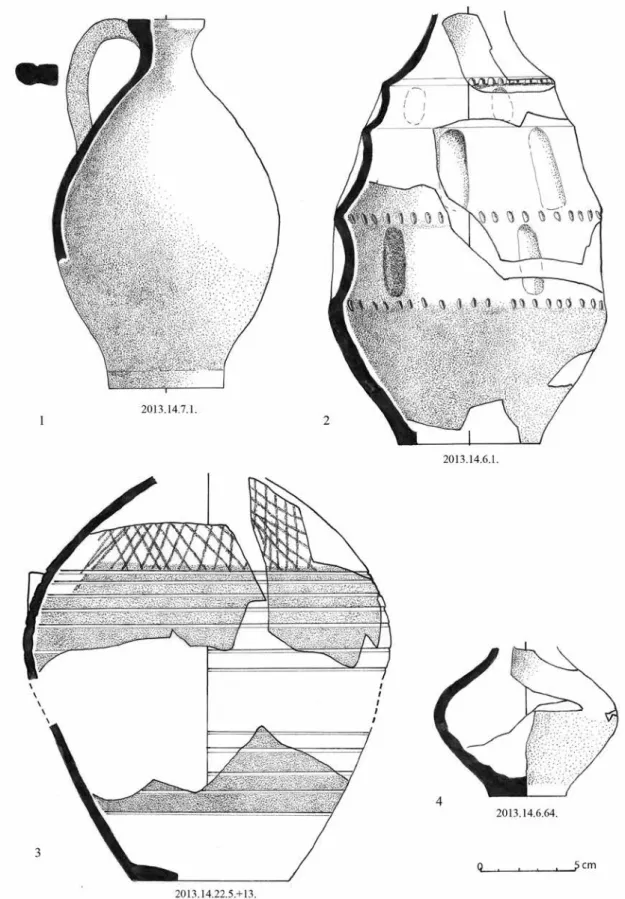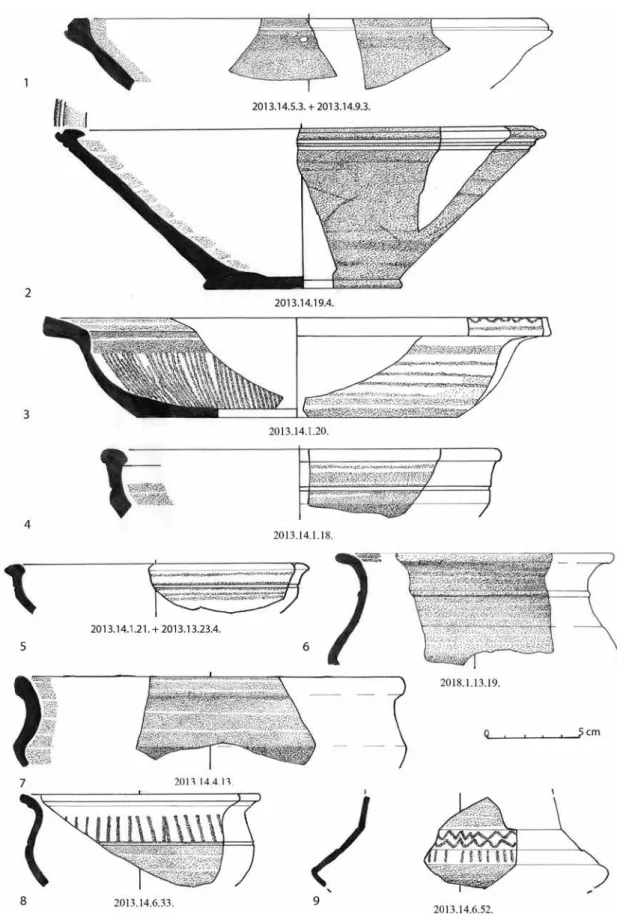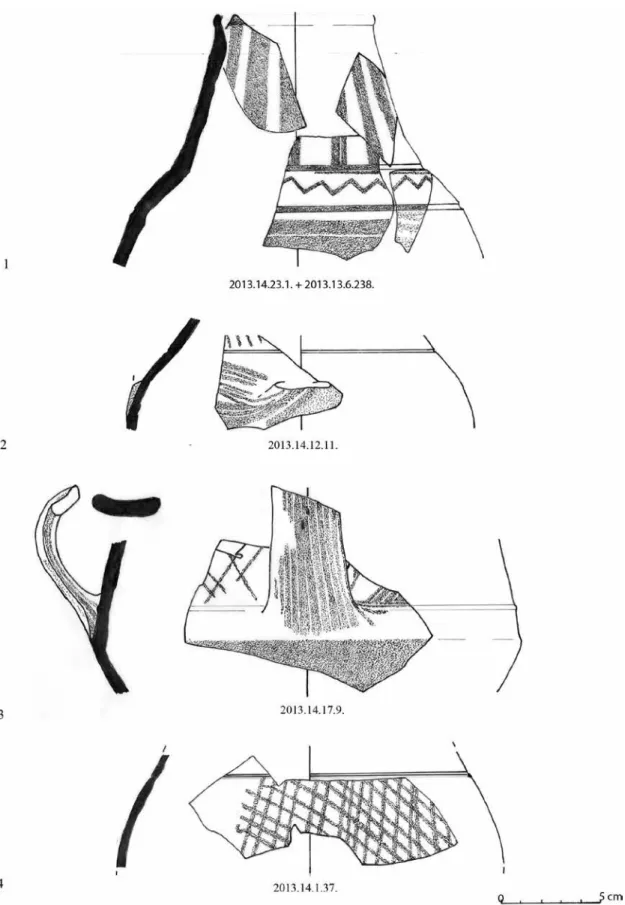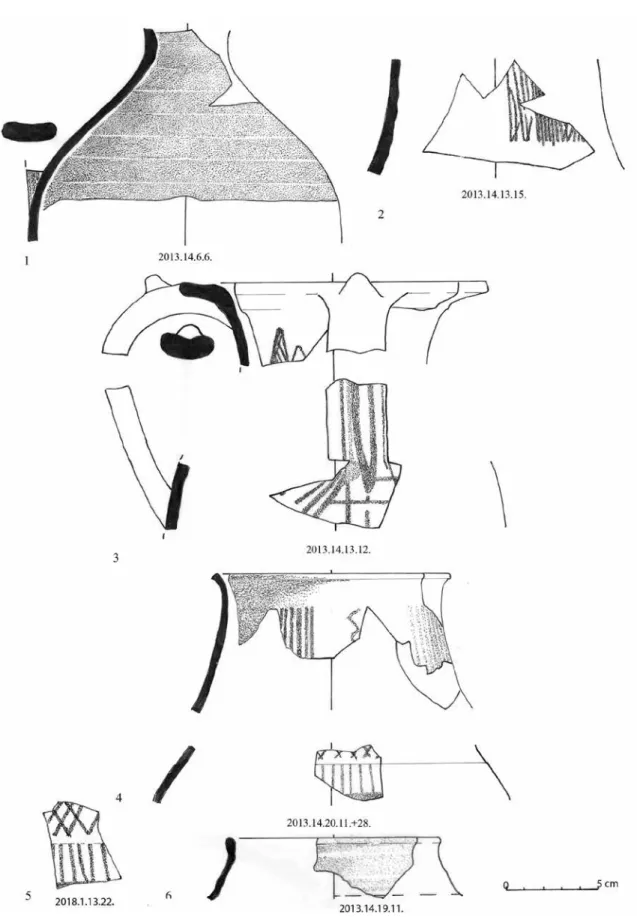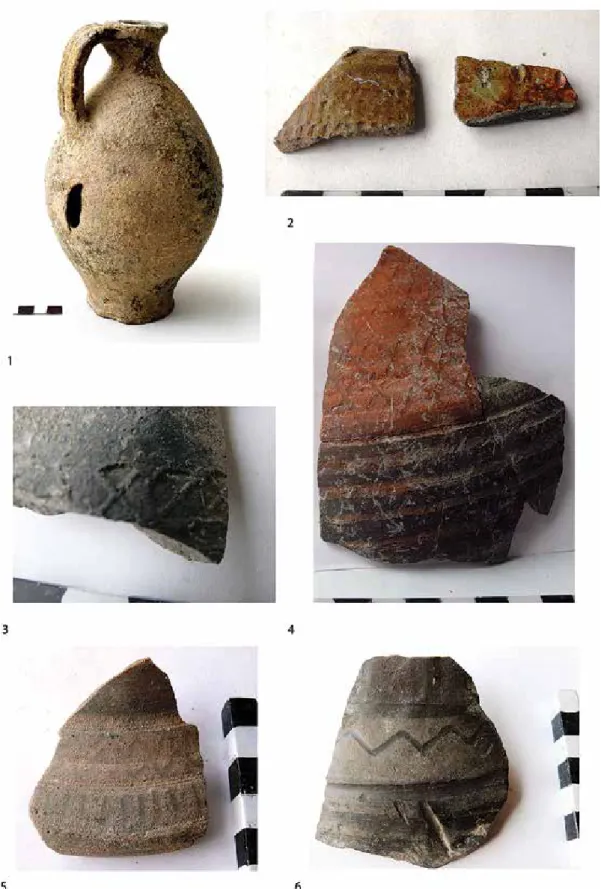Abstract: Pottery at the late Roman fort of Visegrád-Gizellamajor contains both forms common in the 4th century as well as new ones, which appear at the turn of the 4th and 5th centuries. On traditional Roman household pottery and glazed vessels new surface ornaments (incised and notched) and new designs (fired yellowish-white, very gritty fabric) appear. Additionally, there are vessels with smoothed and smoothed-in ornaments. Although the excavators distinguished various layers in the fort, pottery from the layers often fit together. What survived to the greatest extent were the materials from the upper destruction debris. Room III of the north wing was a later addition to the fort; hence its pottery can be dated from the Valentinian period until the Hun period.
Keywords: Late Roman Period, Early Migration Period, pottery, Limes in Pannonia
INTRODUCTION
On the north-eastern border of Pannonia, along the Danube Limes (the province of Valeria) was a dense line of forts and watchtowers during the second half of the 4th century (Fig. 1.1).1 Part of this chain was the rectan- gular small fort excavated between 1988 and 2003 at Visegrád-Gizellamajor. The small fort lies between the forts of Pilismarót and Visegrád-Sibrik Hill, within sight of the neighbouring watchtowers. Strategically, it was in the best location for sighting and defending against attacks by the Quadi from across the Danube, as well as for control- ling trade across the river.
There were fan-shaped towers at the four corners of the fort. Attached to its main walls, on the inside, side- wings (6 metres wide) were built, symmetrically enclosing the inner drill ground. Its gate was on the northern side, facing the Danube. The gate is now partly underneath modern-day Route 11 (Fig. 1.2).2
Its construction can be dated to the mid-4th century, the reign of Constantius II. Remodelling during the Valentinian period can be detected throughout the fort, while at the turn of the 4th and 5th centuries only smaller rooms are attached to the main wings. The stratigraphic position of the latest buildings shows that they were built after the partial destruction of the fort. It was used according to its intended purpose until the 430s, after which it served as a burial site (and perhaps dwelling) of the Huns.
The analysis of the pottery, given the immense quantity, is carried out wing by wing, room by room.3 The present study presents the materials from room III of the north wing. This is simply due to the quantity of the mate-
AT THE VISEGRÁD-GIZELLAMAJOR FORT
KATALIN OTTOMÁNYI
Ferenczy Museum Centre
5., Kossuth Lajos Str, H-2000 Szentendre, Hungary ottomanyi.katalin@gmail.com
Acta Archaeologica Academiae Scientiarum Hungaricae 71 (2020) 15–70 DOI: 10.1556/072 .2020.00002
1 Soproni 1985; ViSy 2003.
2 The small fort was excavated by the archaeologists of the King Matthias Museum Visegrád, Péter Gróf and Dániel Gróh. Gróf– Gróh 1995; Gróf–Gróh–MráV 2001–2002; Gróh 2000; Gróh 2006.
3 West wing: ottoMányi 2012 and ottoMányi 2015b;
South wing: ottoMányi 2015a; Courtyard: ottoMányi 2018a; NW corner tower: ottoMányi 2018b; Room I North: ottoMányi 2018c.
Fig. 1. 1: Late Roman forts in the Danube Bend between Solva and Aquincum (ViSy 2003);
2: The ground plan of the fort uncovered in Visegrád-Gizellamajor
rial, as its nature, forms and types cannot be separated from those in other parts of the wing; indeed there are frag- ments which match pieces from rooms I/N and IIb/N as well as the western half of the courtyard.
1. THE STRATIGRAPHY OF ROOM III NORTH
The north wing was built facing the Danube, parallel to the river. This was the location of the small fort’s entrance, which split the wing into two parts in the middle. Originally there was a room on each side of the gate (I–II/N), from which the corner towers could be accessed. During later modifications, the rooms were split into two, fitted with heating flues, and two new trapezoid-shape rooms were built in front of them. Of these, room III/N nar- rowed the gate passage.4
Room III/N was built later than the fort itself (Period 2). Its original shape was probably rectangular, since the diagonal wall, which gave the room its trapezoid shape, postdates the stone wall of the lower heating flue.5 Its walls were of lower quality; within them ran a heating flue heated from an external furnace from the west (Fig. 2).
The excavators distinguished three layers in the room. The lower heating flue is built on the lowest, clayey layer (this layer is stony on the western side). When the flue was filled in, an intact, glazed jug and an assemblage of jewellery were hidden under the flue cover (Fig. 10.1).6 The upper heating flue system with a furnace (on the same level as the external furnace in the middle of the west wing) is built on top of the filled in flue.7 The upper, new floor is a hard, clayey – with mortar patches in places – floor (Period 3), on which stood a large stone mortar (at the end of the diagonal wall). Above it was the destruction debris with daub and mortar (Period 4).
In terms of absolute chronology, the room which narrowed the gate passage was likely constructed during the remodelling, i.e. during the Valentinian period.8 The upper floor is later; it can be dated to the final third or end of the 4th century.9 The upper destruction debris was the level of the first third of the 5th century, when the room stopped being used in the 430s. In the Hun period a grave was dug into it (grave no. 94/1, in the western half of the room).10
2. POTTERY BY LAYERS
Separating pottery found in room III/N from those from room II/N as well as the western and northern part of the courtyard is problematic. Initially the excavation diary records all rooms west of the gate together. It is only in autumn 1995 that the area in the southern foreground of room II/N is designated room III/N.11 Altogether, I re- corded 1045 fragments from room III/N and its surroundings.
4 Gróf–Gróh 1995, 65–66; Gróh 2000, 20, 28; The other trapezoid-shape room was built in front of room I East and room I North on the mortared pavement of the courtyard, block the entrance of room I/N.
5 Gróh 2000, 20: the originally rectangular room became trapezoid shaped after the construction of the upper heating flue. The new floor, above the old flue, was built onto the western wall of this building.
6 Military brooch, clasp, beads (including amber beads);
somewhat farther: double-sided bone comb (Gróh 2000, 28, Fig. 1.3).
7 The daub debris and black timber beams are on the same level as the top of the lower flue (Fig. 2.2). On the bags there are materials from above the upper mortary layer and the upper clayey layer. This was likely the floor above the new heating-flue. Based on the above, the diagonal west wall would belong to the late-fourth- century remodelling. However, the diagonal wall in room IIb/N (which runs in the same direction) is recorded as a NW-SE wall con- nected with the lower floor, built on clay, above which the next floor was constructed (Gróh 2000, 19).
8 In room III/N several coins of Valens and a few of Cons- tan tius II were found, without closer identification of the layer. The earliest is a coin of Constantine II (337–341) from the mortary layer
between rooms III/N and I/W. In the SE corner of the room was a brick fragment with a QUADRIBURG stamp.
9 This may correspond to period D1 used in the research of the Migration Period. The upper destruction debris may correspond to horizon D2. See BierBauer 2015, 374 (Bierbauer D1: 370/380–
400/410; D2a: 400/410–420/430; D2b: 420/430–440/450; D3:
450/460–480/490; Tejral D1: 360/370–400/410; D2: 390/400–
430/440; D2/D3: 430–460; D3: 450–470/480).
10 Gróh 2000, Fig. 60 (with bronze buttons as grave goods).
11 It is unclear whether the area between rooms I/W and II/N, excavated in 1994, was the western edge of room III/N or the western part of the courtyard (2013.14.1–4.). It may perhaps belong to room IIb/N. It contains materials that match those of rooms IIb/N and III/N, hence I am publishing them here (Fig. 5.1). By 1996 the diary writes clearly about the area between III/N and I/W. The external furnace heating room III/N was located here, in the courtyard between the two buildings (2013.14.10–11.). It was published as part of the western half of the courtyard (ottoMányi 2018a, 116). The gate pas- sage to the north and the areas to its south and west, excavated be- tween 1993 and 1996, too, cannot be always clearly connected with a particular room (foreground of the northern gate: 2013.14.20. and 22;
2018.1.13. and 15.).
Fig. 2. Top view of room III/N (1, 4) and sections (2.: heating flue, 3.: courtyard in front of the room’s southern wall)
Room III/N was built during the remodelling of the fort (Period 2), therefore materials from before the Valentianian period could only appear here in a secondary context. Pottery could not be unequivocally connected with the lowest floor of the room.12 Belonging to the filling between the floors is perhaps the materials from the lower debris (2013.14.22.) and the daub debris above the lower clayey layer (2013.14.19.). In both we can find new-type household pottery and, among the lower debris, even smoothed-in vessels. The vessel and the assemblage of jewellery hidden inside the lower heating flue were buried during the late 4th century remodelling (Period 3). This is the only sealed layer; it is a pity that there were so few pieces of pottery in it (most being new-type household pottery). After the flue was filled in, a new, clayey, mortary floor was constructed above it (2013.14.7. and 12.). On this upper floor stood the stone mortar (2013.14.17.). During the excavation of the floor both smoothed-in and new- type household pottery were found. Most pieces of pottery in the room were found above it (upper yellowish-brown, upper stony brown, above the mortary layer, upper stone debris, upper daub). In this, latest period (Period 4), the whole fort is destroyed and filled in. The matching fragments in the daub layer may be the result of a deliberate infilling of the entire wing. The question is: by whom and when was it filled in?
2.1 Pottery groups
Based on the presence or absence of the various groups (early Roman pottery, glazed, smoothed-in, new, 5th century pottery), I tried to distinguish pottery groups within the fort’s material.13 This also meant chronological differences. Sometimes the pottery groups can be aligned with the layers (e.g. group IIa in the debris above the lower floor; group III in the upper daub). It is, however, more common that in the layers there is a mix of pottery from various groups, e.g. groups Ib and III in the upper debris, groups II–III in the layers above the upper floor etc. At times it even contradicts the stratigraphy, e.g. the latest group III in the lower debris (2013.14.22.). There are, there- fore, no clear layers with connected pottery groups. This is a trend that lasts from the Valentinian period until the first half (or perhaps middle) of the 5th century, and, as time progresses, more and more new-type pottery appears in the debris, while the amount of 4th century pottery decreases.
Group Ia: mixed early and late Roman pottery. Typical 4th century household pottery, few hand-made (no smoothed or glazed). See 2013.14.16. (layer uncertain).
Group Ib: no early Roman pottery. 4th century glazed, smoothed, and household pottery. 2013.14.14. (upper debris) and 2013.14.18. (stone debris). Period 4.
Group IIa: In addition to 4th century glazed and household pottery, also smoothed-in pottery group 2 or late smoothed (few early pottery and some can be later, household pottery): 2013.14.12. (excavation of the floor), 2013.14.13. (stone debris), 2013.14.17. (layer with the stone mortar), 2013.14.19. (daub debris above the lower clay layer). Period 2/3–4.
Group IIb or IIIb: 4th century glazed, no smoothed-in, large amount of new-type household pottery (2013.14.7.: infill of the flue; 2018.1.15.: surface of the debris). Period 3–4.
Group IIc: 4th century glazed (one piece possibly late), one late smoothed, no new-type household pottery (2013.14.15.: above the mortary layer). Period 3–4.
Group III: late glazed, smoothed-in, late smoothed, and new-type household pottery as well as hand-made materials. In some cases there is no late glazed only, smoothed-in, late smoothed and late household pottery (IIIa:
2013.14.5.+9.); no glazed or smoothed-in, only the household pottery represents the 5th century (IIb or IIIb:
2013.14.7.; 2018.1.15.). Period 2/3–4.
Most of the pottery in room III/N belong to this group, although in some cases the 4th century material still dominates and there are very few 5th century vessels (3%: 2013.14.2–4.). A third of the material may be new-type (28–36%: 2013.14.1.,5.), but in most cases half of the material belongs to this kind of late pottery (2013.14.6. -7., 20., 22.; 2018.1.13., 15.).
12 According to the excavation diary, in the furnace pit of lower level’s heating flue there were fragments of a large barbarian vessel underneath the stone debris, as well as a small, squashed bronze
vessel, a millstone and burnt timber beams (diary: 1996.VIII.15.). So far, I have not seen this material.
13 For more details on the groups see ottoMányi 2015a, 5–7.
Its earliest layer is the lower debris (2013.14.22), but this, too, might already be post-Valentinian (Pe- riod 2–3). Most of the late material was found in the upper daub layer (Period 4). More than half (55–67.5%) of the pottery from this layer is a new-type, 5th century vessel. We have only one sealed layer – the infill of the lower heating flue (2013.14.7.) – where there was a conspicuously high amount of late household pottery (63.6%), al- though the glazed vessels found next to them represent traditional, 4th century forms (worn, leaky jug used for a long time). This sealed layer, which was formed through the construction of the new floor and flue above it (Pe- riod 3), dates the use of the following types: white; ribbed; with incised wave motifs; as well as the Leányfalu mug-pot type to the final quarter of the 4th century the earliest or the turn of the 4th and 5th centuries.14 Next to it, the military brooch and double-sided bone comb from the jewellery assemblage indicate that these vessels were used by a mixed group of Roman soldiers and a new, perhaps Germanic, populace (and their families).
2.2 Matching fragments
We can find matching fragments in the various parts of room III/N, and there are also matches with the material from rooms I/N and II/N and even in some cases with that of the west wing (see Table 1).15
Within room III/N: smoothed bowl fragments from the dark brown infill above the clay surface (2013.14.5.3.) and from a bag with an illegible label from room III/N (Fig. 7.1). From this same infill the fabric of a different smoothed bowl fragment (2013.14.5.12.) is very similar to that of a piece from above the clayey brown layer (2013.14.4.21.), so they may have belonged to the same vessel.
Room III/N and the western part of the courtyard: There is a glazed mortarium fragment from the daub debris of room III/N (2013.14.21.2.), which matches the material from above the clayey brown layer in the courtyard between the room and the west wing (2013.14.4.1.: Fig. 5.1).16
Room III/N and room I/N: the matching fragments of a white-slip vessel with a horizontal rim from the room’s daub debris (2013.14.6.107.) and in the daub debris of the neighbouring room I/N (2013.11.6.16.).
Room III/N and room II/N: from this same upper daub debris (2013.14.6.112.), a jug fragment with incised wave motifs matches the material from the upper 20–40 cm of room II/N (2013.12.1.10.: Fig. 13.4). A smoothed small bowl from the upper stony brown part between II/N and the west wing (2013.14.1.21.) matches the material from the infill above the clayey floor of room II/N (2013.13.23.4.: Fig. 7.5). The fragments of a smoothed-in jug come from the infill below and above the mortary floor of IIb/N (2013.13.2.+6.+9.+11.+16.), as well as room III/N (2013.14.23.1.: Fig. 8.1).17
Therefore, the upper debris (daub and greyish-brown) appeared at the same time on top of the walls of the entire wing. Moreover, there is a fragment from this northern daub debris, which fits with the material from the infill above the west wing’s lower floor.18
Levelling in the north and west wing, therefore, took place at the same time. The question is: when? Per- haps when the original floor in room II/N was no longer in use, collapsed or decayed, it was filled up to form a level surface.19 Or, perhaps, when the lower-quality mud-brick walls were built on top and people were still living there (mixed Roman and Barbarian troops), or when these, too, were already levelled (by the Huns)? Since the material from the mud-brick debris, too, matches that of the layer below the floor (room IIb/N), the one from the ruins of these buildings may be the top layer of debris. This could only have happened at the end of occupation, during the first half of the 5th century, or during the Hun period, when other ethnic groups settled among the ruins of the fort.
14 In other parts of the fort there are a few such pieces al- ready in the Period 2 layers from the Valentinian period (e.g. ottoMányi
2015a, 6–7: group III between layers 1–2, group IIIc: layer 2).
15 Had it been possible to lay out and compare the entire ma- terial, or at least that of the rooms of the various wings at the same time, there would be a much greater number of matching fragments. Now, matching pieces can only be found in the cases of conspicuous, unique and easily-distinguishable smoothed-in, glazed or ornamented vessels.
16 From the same location comes a storage jar with yellow- ish-white slip (2013.14.4.17.), the other fragment of which comes from the debris above the courtyard’s clayey, mortary layer (2013.14.3.8.). These three layers were excavated in different years
(1994 and 1999). In the absence, however, of data on depth, I cannot determine the connection between these layers.
17 Smoothed-in jug: 2013.13.2.11–12. room IIb/N upper deb- ris+2013.13.6.238. room IIb/N greyish-brown infill above mortary floor+2013.13.9.2. room IIb/N below the mortary floor+2013.13.11.27.
room IIb/N below the mortary clay debris+2013.13.16.91. (2 pieces) mud-brick section wall, room I/W above the layer 80 cm from the north- ern wall top+2013.14.23.1. room III/N (bag without label).
18 Smoothed-in pot rim fragment (ottoMányi 2012, 377, Fig. 12.10, Fig. 15.2, zs/32.+zs/53.).
19 In room IIb/N, after all, there are matching fragments from the layer both below and above mortary floor.
Table 1.
The pottery of Room III North by layers Cat. no. Layer
(Room III/N)
Glazed
(115 pcs) Smoothed-in
(19 pcs) Smoothed
(124 pcs) Household pottery (gritty, hard) (552 pcs)
Household pottery (well- levigated) (178 pcs)
HM (52 pcs), SW (8 pcs)20
Other Period Pottery group21
2013.14.1.
(+ 2013.13.23.) Area between r. II/N and I/W, upper stony brown, 1994.
(+ IIb/N infill above yel- low, clayey floor, 1996)
21 (5 mor- taria, 11 jugs, 5 other bowls; 6 late white) Fig. 5.5;
Fig. 10.2–3
6 (1 bowl, 4 jugs, 1 frag- ment, 2 lattice, 3 vertical, Fig. 7.3;
Fig. 8.4
17 (Fig. 7.4–5;
1 black, shiny)
55 (21 pcs late:
10 white, 10 ribbed, 1 wavy line on horizontal bowl rim, 1 impression on jug shoul- der)22. Fig. 11.2
17 4 African red
slip ware rim
4 III
(28%)
2013.14.2. + 14.3.+ 14.4. + 14.21.
Surface be- tween r.
IIb/N and I/W, upper yellowish- brown layer (1994) + above clayey, mortary layer (1999) + above clayey brown layer (1994) + r.
III/N NE cor- ner, remo val of daub debris 30–40 cm from the wall (1993)23
20 (10 mor- taria, 1 bowl with inverted rim, 1 bowl with horizon- tal rim, 1 bowl with glaze spot, 7 jugs (2 late, white) Fig. 4.2
1 jug (vertical) 51 (1 bi- conical bowl:
Fig. 7.7)
59 (2 late:
1 ribbed, 1 white;
2 densely incised, 1 broom- stroked) Fig. 12.6;
Fig. 14.4
45 (5 me- dium-hard) 20 +
2 SW(Fig. 16.2)
4 III
(3%)
2013.14.5. +
14.9. South of r.
II/N, room with stone mortar, dark brown above clay surface (1994) + r.
III/N (1994)
3 (mor ta- ri um, other bowl, jug)
1 (diagonal
lines) 10
(1 shiny, black;
Fig. 7.1)
38 (22 late:
9 white, 1 bowl with horizontal rim, 1 Leány- falu, 13 trace of wheel);
Fig. 12.2
8 (Fig. 14.6) 6 4 IIIa
(36. 4%)
20 HM=Hand-made: 52 pieces, one of which is smoothed.
SW=Slow-wheel: 8 pieces, of which two are smoothed. Since the 3 smoothed pieces already appear among the smoothed vessels, I only included 57 items in the total for hand-made and slow-wheel-made vessels.
21 I included here, in parentheses, the ratio (in percentage) within the layers’ pottery of new-type vessels which appeared at the turn of the 4th and 5th centuries. In the table, written in bold, are the latest materials.
22 Of the 10 white fragments, two are ribbed. One jug has impressed motifs. The other 8 ribbed motifs are on grey wall fragments.
23 2013.14.2.–4. Based on the sketch on the bag: not room III/N, but the western part of the courtyard. In 1994 the excavators had not designated room III/N yet, so the label is unclear. But this was also the location of the exterior furnace heating the room. Since it was left out of the paper presenting the courtyard’s material, I am publishing it here, especially since one of the vessels matches the material from room III/N (Fig. 5.1).
Cat. no. Layer (Room III/N)
Glazed
(115 pcs) Smoothed-in
(19 pcs) Smoothed
(124 pcs) Household pottery (gritty, hard) (552 pcs)
Household pottery (well- levigated) (178 pcs)
HM (52 pcs), SW (8 pcs)20
Other Period Pottery group21
2013.14.6.
(+ 2013.12.1.
+ 2013.11.6.)
III/N upper daub layer:
N gate, southern foreground of II/N, 1994 (+ r. II/N 20–40 cm (1994) + r.
I/N upper daub debris 1994)
18 (1 bowl with inverted rim, 3 bowls with horizon- tal rim, 4 other bowls, 2 mortaria, 4 jugs, 4 mugs;
7 late;24 Fig. 4.1, 4–6, Fig. 5.3,7, Fig. 6.2)
2 biconical bowls (verti- cal; wave, in bands;
Fig. 7.8–9, Fig. 10.5)
10 (Fig. 9.1) 134 (89 late:
55 white, 16 Leány- falu, 39 trace of wheel, 11 incisions, 1 broom- stroked);
Fig. 11.3,5;
Fig. 12.5,7;
Fig. 13.1–4;
Fig. 15.2,6
14 (3 me- dium-hard, Fig. 6.4)
1 (Fig. 16.1) 1 painted, spindle whorls (Fig. 12.9–
11)
4 III
(55%)
2013.14.7. By the N gate, fore- ground of II/N (r. III/N) from the in- fill of the flue. 1994. + same location -40 cm, 1995.
2 (mortar- ium, intact jug: Fig. 6.1;
Fig. 10.1)
7 (7 late:
5 white, 5 Leányfalu (ribbed), 1 wavy line, 1 dense lines)
1 (Fig. 14.5) 1 3 IIb/IIIb
(63.6%)
2013.14.12. Western half of room III/N, exca- vation of the floor. (In 1996 the upper floor with the stone mortar was exca- vated)
9 (4 mortaria, 2 bowls with a horizontal rim (of these one with wavy line), 2 other bowls, 1 jug)
1 jug (with diagonal lines;
Fig. 8.2)
9 8 (1 trace
of wheel- ing, 1 in- cised)
24 (3 me- dium-hard), 1 rim of waster (Fig. 14.3)
4 2 neutral-
coloured 3 IIa (2%)
2013.14.13. Western half of III/N, re- moval of the stone debris, 1996
3 (1 bowl with horizon- tal rim, 1 other bowl, 1 jug)
3 (2 jugs, 1 bowl;
2 vertical, 1 Murga;
Fig. 9.2–3)
6 1 6 (1 me-
dium-hard, 1 with pinches;
Fig. 12.8)
2 6 early
(painted, neutral- coloured lamps)
4 IIa
(11%)
2013.14.14. Northern half of Room III/N, upper debris, 1996
2 mortaria 1 5 4 (1 me-
dium-hard) 4 Ib
24 3 yellowish-white, 2 with impressions/notches (one with dented wall), 2 gritty Leányfalu types. There was a lump of green glaze on the burnt foot of one of the jugs.
Cat. no. Layer (Room III/N)
Glazed
(115 pcs) Smoothed-in
(19 pcs) Smoothed
(124 pcs) Household pottery (gritty, hard) (552 pcs)
Household pottery (well- levigated) (178 pcs)
HM (52 pcs), SW (8 pcs)20
Other Period Pottery group21
2013.14.15. By the east- ern wall of Room III/N, above the mortary layer, (1995)
10 (2 bowls with inverted rim, 1 with segmented rim, 1 other bowl, 6 jugs;
1 trace of wheeling) Fig. 4.3
1 shiny,
black 11 2 1 + 2 SW 3–4 IIc
(7.4%)
2013.14.16. Room III/N, corner by the western half, 1996
4 5 (1 Leány-
falu pot, 3 medium- hard;
Fig. 15.1.)
1 9 early
(painted, brick- coloured), spindle whorls
? Ia
2013.14.17. Western half of r. III/N, layer with stone mortar, 1996
4 (1 bowl,
3 jugs) 1 bowl (lattice and diagonal band; Fig. 8.3)
3 6 2 (1 me-
dium-hard) 1 1 painted, 2 whet- stones
3 IIa
(5.5%)
2013.14.18. Room III/N, stone debris by the south wall of the room with stone mortar, south of the gate 1994
1 jug 2 2 4 Ib
2013.14.19. Gate, south of room II/N.
Room with stone mortar, southern side of heating flue, daub debris above lower clay, 1994
2 (mortar- ium, jug;
Fig. 5.4)
7 (1 bi- conical bowl, 1 Leány- falu rim:
Fig. 7.2;
Fig. 11.1)
12 (2 trace of wheel- ing)
6 2 + 2 SW 1 painted 2–3 IIa
(12.5%)
2013.14.20. South of the gateway, from daub, 1993
11 (2 mor- taria, 1 bowl with horizon- tal rim, 1 other bowl, 1 mug, 5 jugs/mugs, 1 handle with glaze spot, 1 mug;
6 late;25 Fig. 4.8;
Fig. 5.6)
1 pitcher (Murga, lat- tice, vertical, trace of wheeling:
Fig. 9.4)
3 83 (74 late:
12 Leányfalu type, 37 trace of wheeling, 5 wavy line, 1 broom- stroked;
Fig. 12.3;
Fig. 15.3)
17 (8 me- dium-hard;
Fig. 14.1)
6 pcs 4 III
(67.5%)
25 5 white (with trace of wheel-throwing on one of them) and one bowl with gritty fabric and wavy rim.
Cat. no. Layer (Room III/N)
Glazed
(115 pcs) Smoothed-in
(19 pcs) Smoothed
(124 pcs) Household pottery (gritty, hard) (552 pcs)
Household pottery (well- levigated) (178 pcs)
HM (52 pcs), SW (8 pcs)20
Other Period Pottery group21
2013.14.22. W fore- ground of N gate, lower debris, – 120-130 cm, 1994
1 mortarium 1 jug (lattice, ribbed:
Fig. 6.3;
Fig. 10.4)
2 pcs 28 (20 late:
5 Leányfalu, 10 trace of wheeling, 14 yellowish- red;
Fig. 15.4–5)
1 1 painted,
whetstone 2–3 III (62%)
2013.14.23.
(+ 2013.13.2.
+ 6. + 9. + 11.
+ 16.)
R. III/N without label26 (+ room IIb/N upper debris, and greyish- brown infill above mor- tary floor + r.
IIb/N under mortary floor, etc.)
1 jug (vertical and wave, shiny black:
Fig. 8.1;
Fig. 10.6)
glass jug
foot 4 III
2018.1.19.1. Next to grave no. 94/1 dug in room III/N (1998)27
1 large pot
(Fig. 16.3) 4
? R. III/N.
From the floor in the room built west and south of the gateway28
intact mug (white, trace of wheeling:
Fig. 11.6;
Fig. 13.5)
? IIIc
?
2018.1.13. Daub close to gateway, 1998
7 (1 mortar- ium, 1 bowl with horizon- tal rim, 4 jug/
pot wall;
6 white;
Fig. 4.7)
1 jug (lattice, vertical:
Fig. 9. 5)
5 pcs (1 black;
Fig. 7.6)
98 (72 late:
2 gravelly, 1 perhaps SW;
43 trace of wheeling, many whit- ish-grey);
Fig. 11.4;
Fig. 12.4)
20 (2 me- dium-hard);
Fig. 14.2 (glaze spot)
4 4 4 III
(61%)
2018.1.15. South of the entrance to N. wing, from the sur- face of the debris, 1993
1 (bowl foot) 3 (3 late: 2
yellowish- white, one of which densely in- cised)
2 (1 not
hard) 1 4 IIb/IIIb
(43%)
26 Two beautiful fragments were removed (smoothed-in vessel and glass foot), but there is no label on the bag.
27 Only one large, hand-made vessel was removed from here. I have not seen the other material yet.
28 The label on the vessel’s box is no longer visible. Based on the diary, an intact vessel was found here in 1993. Other pieces of pottery have not been recorded from here.
3. POTTERY FORMS
Only one imported vessel, an African red slip bowl rim, was found in the upper stony-brown infill (2013.14.1.34.). It is from a Hayes form 61b bowl, which is one of the latest types in Pannonia (second half of 4th century–first half of 5th century).29 The same form is attested in the upper, stony debris of room I/W.30
In Pannonia, in the 4th century, they tried substitute the progressively decreasing number of imported ves- sels using local materials. Metal, glass and terra sigillata imitations were made using new techniques and ornaments.
New techniques included the glazing or burnishing of the vessels’ surface. The latest variants were decorated with incised and smoothed-in motifs. Many small workshops produced locally common everyday household pottery used for cooking and baking, on which, too, the incised and notched ornaments appear from the end of the century. It is characteristic of the period’s pottery that the same bowl and jug types are often used on grey household, glazed or smoothed variants. Painting, still common in the 3rd century, all but disappears in the 4th century. Alongside wheel- thrown pottery, from the second half of the 4th century, the importance of hand-made and slow-wheel-made vessels gradually increases.
The composition of pottery in room III/N is similar to other parts of the fort (Fig. 3.1). Most are household pottery (70%). The dominant group within these are the vessels with a gritty, hard-fired fabric (53%). The quantity of glazed vessels (11%) and pottery with smoothed surfaces (11.9%) is almost the same. Hand-made and slow- wheel-made ceramics make up 5.7%. Least frequent are the smoothed-in ornaments (1.8%).31
3.1. Glazed pottery
Glazed pottery appears in nearly every layer; altogether: 115 pieces.32 From the fort’s construction until its destruction, its inhabitants used glazed vessels. We can make chronological observations based on their designs and ornaments. They were mostly produced in the usual, 4th century way: well-levigated, fired medium-hard or hard.
The latest vessels, characteristic of the first half of the 5th century – yellowish-brown, gritty fabric, with surfaces sometimes decorated with impressed ornaments or traces of wheel – only appear in the topmost, yellowish-brown, stony and daub debris. There are altogether 28 such late fragments (24.3%).33 Their form, too, differs from earlier types (Fig. 3.3): bowls with a horizontal rim and shoulder carination (impression, incision), jugs with one handle (dents, notches), a jug with a collared rim, and so-called Leányfalu-type mug/pot (with trace of wheel). On their surface only a very thin, light-coloured or burnt layer of glaze can be found.
3.1.1. The colour of the glaze and the fabric
The colour of the glaze: Most common are green (28 pieces, 24.3%), dark green (21 pieces, 18.3%), and greenish-brown (16 pieces, 14%) glaze. There is an equal number of pieces with light green and yellowish-brown glaze (13 pieces each, i.e. 11.3%). Of the rest there are only a few pieces: yellowish-green 1 piece, dark brown 3 pieces. There are certain colours, of which the majority are shiny, like dark brown (two out of three shiny) and greenish-brown (10 out of 16 shiny). All three yellowish-brown vessels are shiny, that is not the case with the other colours. A vessel can have glazes of different colours if the contiguous, thick glaze on the inside of the vessel is darker, while the glaze spilled on the outside is lighter, e.g. yellowish-brown on the inside, greenish-yellow on the outside (see 2013.14.15.7.). We can see such lines, spots and glaze patches on the outside of bowls, or the foot or
29 I would like to thank Dénes Gabler for identifying the fragment; a similarly late African red slip fragment came to light in Visegrád-Lepence (GaBler 2016, 141, Fig. 18).
30 ottoMányi 2012, table 1. (zs/5.1). In room I/W 3 Afri- can red slip bowl fragments were found in the upper, stony debris layer (zs/5., 10., 11.): a Hayes form 50 rim and wall (Type D: AD 320–380), as well as a Hayes form 61b bowl rim and a small wall fragment.
31 ottoMányi 2015a, 16, Fig. 7–8 (distribution of pottery in the south and west wing); ottoMányi 2018a, Fig. 1 and 6 (court-
yard); ottoMányi 2018b, 4 (NW tower); ottoMányi 2018c, Fig. 2 (Room I/N).
32 The one layer without glazed pottery: inner corner, room III/N, in front of its western half (2013.14.16.). Here there are rela- tively many early painted and neutral-coloured fragments.
33 Of these 22 pieces are whitish-grey; their fabric is, in all cases, gritty, fired ‘ringing’ hard. The others are reddish-grey, their fabric was hard-fired, or gritty, hard-fired. Ribbing with traces of wheel appears on 3 vessels, of these only one is whitish-grey. Notches appear on 3 vessels and the same number has a wavy rim.
Fig. 3. 1: Pottery composition in room III/N (number of pieces); 2: Vessel forms of glazed pottery (percentage);
3: The quantity of 5th century vessels among glazed vessel forms
ARS (African red slip) pottery
lower part of jugs. On jugs, too, the glaze does not always cover the entire surface of the vessel. In the case of glaze spots it is possible that the vessel was not glazed, the glaze spot got on the vessel when household and glazed pottery were fired together (e.g. yellowish-brown glaze spot on white band handle: 2013.14.20.26.).
There is a very large amount of secondarily burnt glaze (39 pieces); of these the colour of 19 pieces cannot be determined. Sometimes the glaze was fired after the vessel broke (the fracture is also burnt), sometimes it is black only in places, but often the glaze on the whole surface was burnt pitted and blistered.
The fabric and colour of the vessels: Most glazed vessels are well-levigated, medium-hard fired. Later pieces are hard-fired (46 pieces, 40%), half of which is gritty (23 pieces).
Reddish-grey is the most common colour (48 pieces). These include vessels fired in layers (red on the two edges, grey in the middle: 8 bowls, 3 jugs, 1 mug; or red on the outside, grey on the inside: 5 bowls, 1 jug). Often the whole vessel is grey, but on the outside (11 bowls), or inside (3 jugs), there is a thin red layer. The thin red layer can be under the glaze (2 jugs), but often precisely on the other side. And vice versa: the vessel is red, but there is a thin grey layer under the glaze (3 bowls, 3 jugs). The colour of the other vessels is red (25 pieces), grey (18 pieces), and two pieces are brownish-grey. The latest are the vessels, fired yellowish-white, of gritty fabrics (22 pieces), in the case of which either one side or the carination is grey (11 pieces), or, more rarely, pale red (4 pieces).
The relationship between glaze colour and vessel colour: yellowish-brown glaze always appears on red or reddish-grey fabrics and is connected with bowls. As glaze spot it can appear on the exterior of jugs and mugs. Light green glaze primarily appears on vessels made of fabrics fired yellowish-white (jugs, mugs) and on reddish-grey mortaria. Green glaze is the most common: it appears primarily on reddish-grey vessels, but also often on vessels made of yellowish-white and grey fabrics. Dark green glaze is typical for grey and reddish-grey jugs, less often for bowls. Greenish-brown glaze mostly appears on vessels made of reddish-grey and red fabrics, on all kinds of forms.
Dark brown glaze in typical for red vessels. Burnt glaze can appear on vessels of any colour; most frequently on jugs and mugs fired yellowish-white (Table 2).
The fabric of the latest vessels is whitish-grey, whitish-red, the glaze on them is mostly burnt, light in colour, mostly light green (very thin, barely visible, sometimes only surviving in traces), see 2018.1.13.
The colour of the glaze depends on the workshop. After all, usually the basic glaze colours are produced by different kinds of firing. Oxidation firing produces yellow (yellowish-brown, yellowish-green), while reduction firing produces green (greenish-brown). This also impacts the colour of the fabric. The fabric of vessels with yellow, yellowish-brown glaze became red through oxidation firing, while the fabric of vessels with green, greenish-brown glaze, through reduction firing, is mostly grey.34 Often, underneath the glaze, a thin layer, fired a different colour, can be observed. Its colour, too, depends on the method of firing; e.g. on a vessel made of a grey fabric the thin layer under the glaze is red, while on a vessel made of a red fabric it is grey.35
Waster: The fragment with a melted, shiny green glaze lump stuck on the glazed foot, is perhaps a waster (2013.14.6.90.).
Table 2.
The relationship between the colours of the glaze and the fabric colour of the
fabric yellowish-
brown glaze light green
glaze green glaze dark green
glaze greenish-
brown glaze brown glaze burnt glaze
grey 1 6 9 2 3
reddish-grey 3 5 14 12 10 4
red 8 1 4 1 5 2 4
yellowish-white 1 6 6 1 8
34 ottoMányi 1991, 14–15; MiklóSity Szőke 2008, 172 (footnote 122 with further references).
35 horVáth 2011a, 606.
3.1.2. Vessel forms
Vessels with a glazed surface were primarily tableware (Fig. 3.2). Most are bowls (62 pieces) and jugs (39 pieces). Mugs are significantly fewer (14 pieces).36 At first they imitated sigillata, metal and glass vessels with the glazed surfaces. Later on glaze came to be applied on regular household pottery forms as well, especially if they were locally produced.37
Bowls (62 pieces)
Half of the bowls are mortaria (30 pieces). There are far fewer bowls with a horizontal rim (9 pieces), and with an inverted rim (4 pieces); there is also a bowl with a segmented rim and conical base as well as mug with a handle. In the absence of rims, the forms of foot or wall fragments with glaze on the inside remain unclear (17 pieces).
Mortarium: a vessel typical for Roman culinary culture. Its grit-roughened interior made it suitable for grinding spices and making sauces during the first three centuries of the Roman Period. In late Roman mortaria, the glaze was applied on top of the gritty surface; its function, therefore, must have changed partially. However, if we look at the quantity of mortaria among glazed vessels, which is always the highest on all Roman sites – be they military or civilian settlements – it is likely that mortaria continued to play a significant role in dining; perhaps no longer as kitchenware, but as serving vessels.38
Most mortaria are well-levigated, medium-hard fired and red, or reddish-brown (fired in layers), with greenish-brown or green glaze on the inside and rim. The rim of the earliest variant is painted, its glaze shiny yel- lowish-brown (2013.14.3.2.). If the fabric is grey, the glaze is green or dark green. The latest yellowish-white or yellowish-grey vessels were made with green glaze and of a hard-fired, rarely gritty, fabric (5 pieces: 2013.14.1.1.
and 2. and 7., 2013.14.2.3., 2018.1.13.6.).39 All late pieces are from the upper stony and daub debris, but earlier types were also found along them.
Their collared rim can be segmented (Fig. 5.1), while by the late 4th century the upright, shortening collar becomes progressively more prevalent (Fig. 5.2–4).40 Their wall – unlike the earlier, more spherical bowls – is steep and conical. Their mouth diameter varies between 13 and 25 cm, most are larger bowls.
Bowls and cups with a horizontally everted rim: There are both smaller cups and larger bowls with such rims. They may have been part of a dinner set. The form is a traditional, 4th century type (imitation of metal vessels and African red slip ware), which appears in the second half of the century with a glazed design.41 Its fabric is red, reddish-grey; its glaze green, greenish-brown. In room III/N there are five such fragments. On the rim of one there is an incised wavy line, which, for this type, is characteristic of the later vessels (2013.14.12.1.). Based on its fabric, however, it does not belong to the latest, 5th century group.42 The exterior of a larger, flat bowl is smoothed (Fig. 4.4), with burnt greenish-brown glaze on the inside.43
36 The rim did not survive in the case of every fragment;
nor is the form always clear. In these cases fragments with glaze on the inside were classified as ‘other bowl’, while fragments with glaze on the outside were classified as ‘jug’, though the latter might also have belonged to mugs. Handles clearly belonged to jugs.
37 Applying glaze to household pottery came to be practised in Pannonia from the Valentinian period or the last third of the 4th century. See: Tokod (lányi 1981, 73; BóniS 1991, 135); ottoMányi
1991, 20 (Leányfalu); MiklóSity Szőke 2008, 170–171 (Brigetio).
38 For references on the dating and spread of the vessel type see ottoMányi 2015a, footnote 154; CVjetićanin 2006, 21–29, LRG 1–8 (late 3rd century–early 5th century); horVáth 2011a, 606–609, Fig. 5; BóniS 1991, 89, 123–129; At the Győr fort it is still attested in phase 1A–B of the Migration Period, during the early-5th century (toMka 2004, Table 2.1, Table 3.2, Table 4.2).
39 ottoMányi 2018a, 106 (courtyard) and there is a piece from the SW tower as well as room I/N (ottoMányi 2018c, 124).
40 ottoMányi 2015a, 27–28, Fig. 7.5 (segmented), Fig. 7.6, 8; ottoMányi 2015b, 710; ottoMányi 2018a, Table 4. 6;
ottoMányi 1999, 338, Pl. II. 4–7; horVáth 2011a, Fig. 4.1. and 5 (Keszthely-Fenékpuszta, segmented rim); GaSSner 2000, 219–221, Fig. 186; ŠVaňa 2011, Fig. 3.1a–c (Iža: after Valentinian); CiGlenečki
1984, Fig. 3.38 (Tinje).
41 Cup: CVjetićanin 2006, 34–39, LRG 27; horVáth
2011a, 609–611, Fig. 4; Groh–SedlMayer 2002, Fig. 132/669 (Hayes form 52 imitation, Mautern, 350–400/500 CE); Bowl: CVjetićanin
2006, 51–55, LRG 71; BóniS 1991, 129–131, Fig. 9.1–7; The form is characteristic for periods 6–7 of the Mautern fort (Groh–SedlMayer
2002, 185–186, Fig. 132.802); it also lives on at highland sites in Slovenia during the 4th–6th centuries (CiGlenečki 1984, Fig. 3.32–34).
42 ottoMányi 1991, 16, Table 10. 52; BóniS 1991, Fig. 9.4;
CiGlenečki 1984, Fig. 3.34–37 (Tinje: wavy line and impression on the rim of flat bowls. 4th–6th century).
43 Similar flat bowls with a smoothed exterior at the west wing and the courtyard in front of it (ottoMányi 2015a, 29, Fig. 11.5,7; ottoMányi 2018a, Table 4.1); Leányfalu: ottoMányi
1991, Table 12.62.
Fig. 4. Glazed bowls
A later variant is the bowl, similar to the S-profile, with shoulder carination and a conical base. It is com- mon not only in glazed but also in household pottery form from the last third of the 4th century. There are impres- sions on its neck; its fabric is gritty, hard-fired (Fig. 4.5).44 The edge of three smaller cups, too, was made wavy with impressions (Fig. 4.6–8).45 Their fabric was hard-fired, gritty. Their colour is yellowish-white, and in one case red.
They all have burnt glaze on the inside. These later items were found in the daub layer (2013.14.6., 14.20. and 2018.1.13.). In the same topmost daub layer there were also more traditional, earlier forms. These were also found during the excavation of the floor (2013.14.12.).
Bowl with an inverted rim (4 pieces; Fig. 4.1–2): traditional Roman bowl form (neutral-coloured, painted, grey variants), with the inside sometimes glazed in the 4th century.46 Their fabric is red, reddish-grey, well-levigated, medium-hard fired. On the inside there is light-coloured glaze (greenish-brown, light green, yellowish-green) and in one case pitted burnt glaze. It was found in the upper destruction layer 3–4.
Bowl with segmented upper part and conical base (Fig. 4.3): This type can be connected with an early Roman form, which reappears with such a steep, conical lower part only in the last third of the 4th century. It appears most frequently as smoothed or household pottery. In room III/N it was found above the mortary layer, which can be connected with the destruction debris. Based on its shiny, brown glaze and design it cannot be placed in the lat- est group. It can also be found in other parts of the fort.47 The closest analogies are the bowls found at the Valentini- an-period watchtowers at Pilismarót-Malompatak, Leányfalu and Budakalász-Luppacsárda.48
Cup with stabbed ornaments inkább stitched decoration (2013.14.1.10.; Fig. 10.2). A distinctive form, which already appears in the mid-4th century, is the cup with two-three handles, with a number of bands of stitched ornaments on its vertical upper part.49 The fragment of such a cup was found in the upper stony layer. Its fabric is hard-fired, yellowish-grey, its glaze light green. This type was still in use during the first half of the 5th century.
Based on the Visegrád fragment’s design, it can be placed also in the later group.
Among the fragments of unidentifiable bowl forms, glazed on the inside (17 pieces), there are two foot fragments; the rest are wall fragments. Of these the fabric of 3 is whitish-yellow, gritty, hard-fired. On another frag- ment there are traces of wheel (2013.14.15.4.).
Jugs (39 pieces)50
Belonging to this group are the neck and wall fragments, feet (6 pieces) and band handles (4 pieces) with glaze on the outside. One of the broad, tripartite handles belonged to a large jug (2013.14.6.89.), with burnt glaze on it.51 On another there is only a glaze spot (2013.14.20.26.: its fabric white, gritty). There are few rims (3 pieces) and even fewer intact vessels (1 piece).
44 CVjetićanin 2006, 34, LRG 24 (impressions on the neck), 43, LRG 42 (wavy line on the rim), 51–53, LRG 69a, 70 (S-profile); Grünewald 1979, Table 67.2; jelinčić 2015, Table 151.91 (impressions on the rim: 3rd –early 5th century).
45 ottoMányi 2015a, 28–29, Fig. 11.3, 6 (notches on the rim); ottoMányi 2018b NW tower (Fig. 4.2–3: notches and circular impressions); ottoMányi 1999, 337, Pl. I.9–10 (Dunabogdány);
Grünewald 1979, 71, Table 67.9; toMka 2004, Table 3.3 (Győr, phase 1B); CVjetićanin 2006, 56, LRG 75. bowl with circular impres- sions on the rim; jereMić 2012, Fig. 3. Cat. no. 206., 210., 211. (Sal- dum, Valentinian period).
46 ottoMányi 1991, 15, Table 1.5,8 (Leányfalu);
ottoMányi 1999, 336, Pl. I.1–4 (Dunabogdány); frieSinGer– kerChler 1981, Fig. 7.2; MiklóSity Szőke 2008, 165, Table III.4–5 (Brigetio); BóniS 1991, 131, Fig. 5.6 (Tokod); ottoMányi 2011, 267, Table 2.1 (Budaörs, turn of the 4th and 5th centuries); CVjetićanin
2006, 49, LRG 61 (turn of the 4th and 5th centuries); ottoMányi– SoSztaritS 1998, Table III.7–8 (mid-5th century, Szombathely).
47 ottoMányi 2015a, 29, Fig. 3.2, Fig. 7.10.
48 ottoMányi 1991, 15, Table 2.11–12a (the colour of the glaze is yellowish-brown); ottoMányi 1996, 95, Fig. 3.6,6a;
ottoMányi 2004, 269, Table I.6–7 (with further analogies); GaSSner
2000, 217, Fig. 185 (Mautern).
49 ottoMányi 2011, 266–267, Table 2.6–8, Table 6.3 (Budaörs: coins between 351 and 375); nádorfi 1992, 50, Table II.3a-b;
BóniS 1991, 131–133, Fig. 18.2 and pottery workshop: Fig. 10.5;
horVáth 2011b, 210, Fig. 94.K229 (late-3rd century–Valentinian period).
50 There are a few additional, thin wall fragments, which may equally belong to jugs or mugs. I currently included them with the mugs based on their colour and design (8 pieces, probably Leány- falu-type). The form of many wall fragments glazed on the outside is uncertain (they might have been mugs as well). Based on its fabric, a red small jug fragment with white slip on the outside may have been glazed, although no glaze remained on its exterior (Fig. 6.4).
51 In the south wing of the fort a conspicuously high num- ber of such large glazed jugs with one or two handles were found (ottoMányi 2015a, 30–31, Fig. 3.8, Fig. 12.1). Also found in the west wing, in the burnt, daub debris (ottoMányi 2015b, Fig. 7.5, Fig. 10.2); in room I/N (ottoMányi 2018c, Fig. 2.3: of yellowish- white fabric, with collared rim); In Pannonia, during the late-4th cen- tury, large glazed jugs appear in other sites as well with different rims, e.g. Budaörs: (ottoMányi 2011, 269, Table 4.11); Tokod: BóniS 1991, 135–139, Fig. 7.1, Fig. 8.13; Moesia, Dacia: CVjetićanin 2006, 81–
82, LRG 126–128 (amphora, second half of 4th century).
Fig. 5. Glazed mortaria, jugs, mugs
Fig. 6. Glazed (1–2), smoothed-in (3) and brick-coloured (4) jugs

